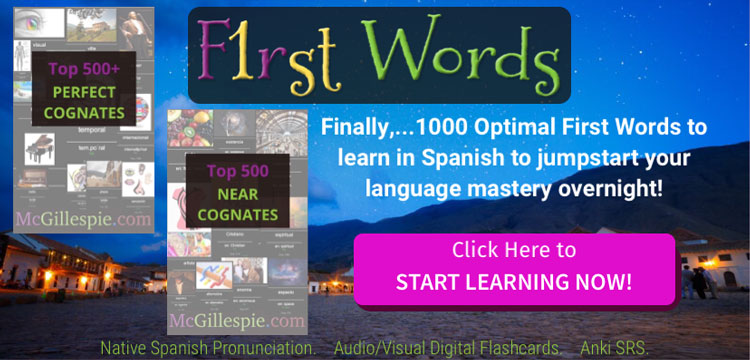On a recent trip to Colombia, I was determined to teach our two boys Spanish. It was a six-week trip, and I quickly ran into two problems.
Immersion was Unavailable
The first problem was the Spanish speaking children our boys found to play with saw them as an opportunity to practice their English. We’d flown all the way to South America to be immersed in Spanish, but we couldn’t escape English.
The second problem was me. I didn’t know the language well enough to provide parental services in Spanish only. In other words, hanging out with dad was no immersion experience, either.
An Optimal Beginning?
What I needed was an optimal way to begin. If the first thing presented to the boys was frustrating, they might lose interest in Spanish altogether. That’s what happened to me in high school, college, and three other Spanish courses that seemed promising. Something didn’t click, and I didn’t know why.
With my children’s language acquisition at stake, I was determined to get to the bottom of flaws in the traditional approach that hadn’t worked for me.
Eureka!
While scouring the web for solutions, the eureka moment came when I discovered A Frequency Dictionary of Spanish by Mark Davies. Davies used computers to analyze 20 million words of Spanish across three “registers” of fiction, nonfiction, and radio. His dictionary lists the top 5000 most frequently used words in the Spanish language. All the more stunning is how important these words are to new language learners.
Using English as a comparison, Davies estimates that you would understand ~90% of every word spoken or written in Spanish if you knew the top 3000 words. And, your comprehension would rise to 95% if you knew the top 5000 words.12
What better way to learn a language than by focusing on learning the most frequently used words first?
Purifying the Gold
Merely presenting Davies list to the boys would have been great, but I wondered if we could do better. After scouring through all 5000 words, I noticed that many of them were similar to the same words in English. In fact, every other word had similarities.
In all, I found ~10% of them (532 words) were nearly identical in spelling and meaning in both Spanish and English. Such words are called perfect cognates, and there are lots of them on Davies’ list.
What if I focused the kids on learning these related words first?
Even Better
With 532 perfect words to begin learning Spanish, I wondered if I could make the boys learning experience even better.
My studies revealed how pronunciation and ear tuning is crucial to language acquisition. Was it possible to have each word pronounced for the boys in perfect Spanish?
Yes! I could ask their grandmother to present the list to the boys. She is a native Colombiana and would pronounce each word correctly!
For my own learning, I switched my smartphone and tablet settings to Spanish. Words and sentences could then be highlighted and read aloud in Spanish. I don’t know if Paulina or Juan are real people, but they taught me how to pronounce thousands of words in Spanish!
From Gold to Platinum
Since returning from our trip, I’ve found four more ways to improve on the optimal first words we discovered for learning Spanish. Each improvement stems from observing the best learning techniques I could find:
- Associate each word with a picture.
- Have each word read aloud, automatically, using Native pronunciation (in case your Colombian grandmother isn’t available.)
- Keep track of progress and the words they have trouble with and present those words differently.
To accomplish the first three, I found a digital flashcard app called Anki (the Japanese word for memory.) Anki does 1,2 and 3 and uses an algorithm to show the words you’re having trouble with more frequently until you get them down. Words you have no problem with are only displayed when you’re just about to forget them (which turns out to be the best way to improve your recall.)
Anki is free and works on all platforms. Here’s what some of “First Words” looks like on the desktop, smartphone, and tablet:
The 4rth Improvement
The 4rth improvement was discovered by going back through Davies’ list. What would be the next ideal batch of Spanish words to learn?
By allowing for words that have up to three characters difference between English and Spanish (but still have the same meaning) it wasn’t hard to find a second optimal batch of 500 words. These allow for minor spelling changes such as replacing the ’t’ with ‘c’ in ’edición’ vs. ‘edition’ and ‘nacional’ vs. national. They also allow for an ‘o’ or ‘a’ after the word as in ‘humano’ vs. ‘human’ and ‘diferente’ vs. ‘different.’
It’s a rare (non-existent?) student who might be thrown off by the minor spelling changes I’ve allowed for in the ‘non-perfect’ portion of the list. But the payoff is enormous!
If you combine the first (532) and second (500) word lists, 787 of them are in the top 3000. These words are used so frequently in Spanish, you’ll rarely read or hear a sentence formed without one!
Hiding in Plain Sight for 100 Years
Before 2006, these words were hidden in plain sight due to the absence of a robust frequency dictionary.3 Since then, “First Words” may be the first serious effort to identify all cognates in the top 5000 and present them in an optimal learning format (Anki digital flashcards.)
It took a while, but I eventually input all 1032 words into digital flashcards. Each word has just the right picture, and each is pronounced by a native Spanish speaker. Words you learn easily are only re-presented when you’re just about to forget them (to optimize recall.) Words you find harder are presented more often until they are learned.
The results have been worth it. Not only are my boys off to an optimal start, but the cards can also be made available to others to set upon their own optimal start in learning Spanish!
Suitable for ALL Ages
In case you’re wondering what this looks like, here’s our youngest going through his Spanish cards for the day.
Many of the top 1000 cognates are advanced words that young children may not yet know in their native English. Nevertheless, they are the most frequently used words in the Spanish language and, therefore, pure gold for anyone learning Spanish.
- Davies, Mark, 2006, A Frequency Dictionary of Modern Spanish, Routlegde: “Nation (1990) has shown that the 4,000–5,000 most frequent words account for up to 95 percent of a written text and the 1,000 most frequent words account for 85 percent of speech. While Nation’s results were for English, they do at least present the possibility that, by allowing frequency to be a general guide to vocabulary learning, one task facing learners – to acquire a lexicon which will serve them well on most occasions most of the time – could be achieved quite easily.” ↩
- Nation, I. S. P. (1990), Teaching and learning vocabulary, Boston: Heinle and Heinle. ↩
- There have been a number of other frequency dictionaries and lists for Spanish (Buchanan 1927, Eaton 1940, Rodríguez Bou 1952, García Hoz 1953, Juilland and Chang-Rodríguez 1964, Alameda and Cuetos 1995, Sebastián, Carreiras, and Cuetos 2000), but all of these suffer from significant limitations. ↩





